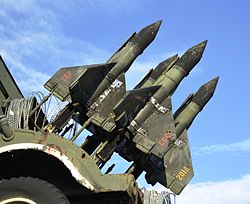3M6 Shmel
This article includes a improve this article by introducing more precise citations. (November 2014) ) |

The 3M6 Shmel (
Too large to be manportable, it was typically deployed from specialised vehicles or helicopters. The missile was intended to supplement traditional anti-tank weapons, like the
However, the system's bulk, slow speed and poor combat accuracy drove development of later
Development
The 3M6 Shmel began development through Decree No. 7 on May 27, 1957.
Development of the missile proceeded rapidly, with the first unguided flights in April 1958 followed by controlled flights in June and July 1958, where testing showed the probability of a hit to be anywhere from 75—90%, depending on the range.[7] However, Soviet Army field exercises showed that hit rates could decrease to as low as 25% due to the complexity of the guidance system.[8]
Reveal and Western reaction
The system would enter service by August 1st, 1960.[9] Later, parade 2P27 vehicles sporting four 2K16 launchers on May 1st, 1962 were noted by Western observers in parade formation, just before the 1962 Moscow Victory Day Parade.[10] The weapon would later be described in the US Army journal Military Review as being 'about the same size' and having 'approximately the same range' as the French SS.11, later overestimating its range to be from 500 to 3,000 metres.[11]
History


There were two ground-based platforms for the missile
- 2P26 Based on the unarmored GAZ-69 light truck - with four backward pointing launch rails. The control station can be deployed up to 30 m away from the launcher vehicle. It entered service in 1960
- 2P27 Based on the armored BRDM-1 - with three pop up launch rails protected by an armored cover. It entered service in 1964.
These vehicles were deployed in anti-tank batteries attached to motor rifle regiments. Each battery has three platoons, each with three launch vehicles and a single command BRDM.
While a few were used by Egyptian forces during the 1967 Six-Day War and from 1969 in the War of Attrition, only one tank loss was attributed to the system. The system's hit probability is estimated to have been 25% in combat[citation needed].
The system was also used by the
North Korea began producing a reverse-engineered version of the missile in 1975.
Description
The missile is guided to the target by means of a joystick, which requires some skill on the part of the operator. The operator's adjustments are transmitted to the missile via a thin wire that trails behind the missile.
The missile is steered by an unconventional arrangement of vibrating spoilers.
As stated before, MCLOS requires considerable skill on the part of the operator. The system's effectiveness in combat drove the development of missiles based on the easier to use SACLOS system.
One problem with the missile is the amount of time it takes to reach maximum range—around 20 seconds—giving the intended target time to take action, either by retreating behind an obstacle, laying down a smoke screen or firing on the operator. Also, the large size of the missile means that only a few rounds can be carried; the BRDM-1 vehicle can only carry three missiles.
Operators
Current
Former
 Afghanistan[14]: 766
Afghanistan[14]: 766  Algeria[14]: 766
Algeria[14]: 766  Bulgaria[14]: 767
Bulgaria[14]: 767  Cyprus − 80 missiles received in 1973 in violation of the Greek and Turkish Cypriot arms embargo.[15]
Cyprus − 80 missiles received in 1973 in violation of the Greek and Turkish Cypriot arms embargo.[15] Czechoslovakia[14]: 768
Czechoslovakia[14]: 768  East Germany[14]: 768
East Germany[14]: 768  Egypt[14]: 768
Egypt[14]: 768  Hungary[14]: 769
Hungary[14]: 769  Iraq[16]
Iraq[16] Israel - Captured units from Egypt[17][18] and Syria.[citation needed]
Israel - Captured units from Egypt[17][18] and Syria.[citation needed] Mongolia − 100 missiles received in 1963.[15]
Mongolia − 100 missiles received in 1963.[15] Poland[14]: 772
Poland[14]: 772  Romania[14]: 772
Romania[14]: 772  Soviet Union[14]: 406
Soviet Union[14]: 406  Syria[14]: 773
Syria[14]: 773  Yugoslavia[14]: 774 - 500 missiles received between 1964 and 1965.[15]
Yugoslavia[14]: 774 - 500 missiles received between 1964 and 1965.[15]
General characteristics
- Length: 1150 mm
- Wingspan: 750 mm
- Diameter: 136 mm
- Launch weight: 22.5 kg
- Speed: 90 to 110 m/s
- Range: 500 m to 2.3 km
- Time to maximum range: 20 seconds
- Guidance: MCLOS
- Warhead: 5.4 kg RHA
References
- ISBN 5170117442.
- ^ ISBN 978-5-903603-02-2.
- ^ ISBN 5-17-011177-0.
- ISBN 5-7038-1407-3.
- ISBN 978-5-903603-02-2.
- ISBN 5-7038-1407-3.
- ISBN 978-5-7038-3158-8.
- ISSN 0236-0586.
- ISBN 5170117442.
- ^ Military Review (Volume XLIII, Number 2, February 1963 ed.). Fort Leavensworth, Texas: United States Army. February 1963. p. 105.
- ^ Military Review (Volume XLIII, Number 1, January 1963 ed.). Fort Leavenworth, Texas: United States Army. January 1963. p. 106.
- ISSN 0459-7222. Retrieved 16 April 2024.
- ISSN 0459-7222. Retrieved 16 April 2024.
- ^ ISBN 978-0710608574.
- ^ a b c "Trade Registers". Stockholm International Peace Research Institute. Retrieved 24 May 2023.
- ISBN 978-0-87364-632-1.
- ^ Олег Грановский, Вадим Яковис (2005-01-15). "ПТУР первого поколения в АОИ". War Online (in Russian). Archived from the original on 2006-05-16. Retrieved 2023-11-05.
- ^ Олег Грановский (2018-09-09). "История начала разработок ПТУР в Израиле". oleggranovsky.livejournal.com (in Russian). Archived from the original on 2021-04-15. Retrieved 2023-11-06.
- Hull, A.W., Markov, D.R., Zaloga, S.J. (1999). Soviet/Russian Armor and Artillery Design Practices 1945 to Present. Darlington Productions. ISBN 1-892848-01-5.
- Jane's Weapon Systems 1977
- ПТУР первого поколения в АОИ in Russian
- 2P26 (GAZ-69). Vehicles in Russia. Silver collection. Vol. 15 (2nd ed.). Russian Motor Books. 2003.
